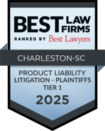
The heartbreaking deaths of twin 6-year-olds who were not in child safety seats when their mother wrecked the car they were in last month reminds us that many children in South Carolina are at risk of injury in car accidents because they are not properly restrained in moving automobiles.
Jennifer Lynn Knox, 38, of Seneca, S.C., was jailed in Pickens County after the crash that killed Dylan and Camryn Clark on May 26, according to the Greenville News. She was charged with two counts of felony DUI resulting in death, child endangerment, and two counts of child restraint violation and seat belt violation. She had been cited on May 17 for speeding and a child passenger restraint violation in Oconee County.
In a follow-up report, the Greenville News says approximately 11,500 children under age 6 were involved in a car or truck accident in South Carolina in 2017, the year of the most recent data available. More than 20 percent of them, 2,400 children, were not restrained by a child safety seat.
“Based on 2017 figures in South Carolina, one unrestrained vehicle occupant is killed every 27.5 hours,” the newspaper says. “One child under 6 is seriously injured or killed every 9.4 days.”
Child Car Seat Safety Regulations
South Carolina’s child car seat law was updated in 2017. The regulations say that children younger than 2 years old must be in a rear-facing child seat in the vehicle’s rear seat. Kids up to age 8 or up to 4 feet, 9 inches tall (57 inches) have to be in a forward-facing child seat or booster seat in the rear seat. At age 8 or 4 feet, 9 inches tall, a child may be restrained by a seat belt if it fits correctly.
A child is properly secured by an adult seat belt if:
- The lap belt fits across the child’s thighs and hips and not across the abdomen,
- The shoulder belt crosses the center of the child’s chest and not the neck, and
- The child is able to sit with his back straight against the vehicle seat back cushion with his knees bent over the vehicle’s seat edge without slouching.
However, it is the installation of child safety seats that causes parents problems and puts kids at risk. The National Highway Traffic Safety Administration (NHTSA) conducted the National Child Restraint Use Special Study (NCRUSS) in 2011 and released findings in 2015.
The NCRUSS estimated that 46 percent of car seats and booster seats were misused. A follow-up released in July 2018 found that 49 percent of car seats and booster seats observed in use were being misused in at least one identifiable way.
Child Car Seats Misuse in South Carolina
“‘Misuse’ was defined as a characteristic of installation or use of a car seat/booster seat that may reduce the protection of the child in a crash. Installation did not have to be perfect. Only deviations that might compromise the protective function were defined as misuses for the purposes of the NCRUSS,” the follow-up study report says.
Car and booster seat misuse was defined according to problems with installation of the seat – i.e., strapping and buckling it into the vehicle’s seat – and problems with child restraints (in booster seats or seat belts).
In rear-facing infant and convertible seats, the most common misuses (excluding those specific to installation) were:
- Child is younger than 1 year old and the angle of the seat is less than or equal to 30 degrees.
- Loose installation, where the car seat could be moved more than 2 inches laterally.
- Harness slack exceeding 2 inches.
In forward-facing car seats, the most common misuses were:
- Loose installation, where the car seat could be moved more than 2 inches laterally.
- Harness slack exceeding 2 inches.
- One or more harness straps behind the child’s arm, back, or leg.
In high-back and backless booster seats, the most common misuses were:
- Lap belt across child’s abdomen and/or ribcage.
- Shoulder belt behind the child’s arm or back.
The most common installation-specific misuses were:
- Installed with seat belt and ELR mode, and latch plate is not switchable — locked or locking, seen most often in rear-facing infant seats and forward-facing seats. [Emergency Locking Retractor (ELR) is a seat belt retractor that locks only in response to the rapid deceleration of a vehicle or rapid spooling out of the seat belt webbing from the retractor. The ELR was designed to allow seat belt webbing to move freely once the seat belt is in place but lock instantly in the event of a crash. ELR should not be used to hold a child seat in place. The belt will still lock in a crash, but the child seat could move enough to hit some part of the vehicle during the crash or upon impact.]
- Installed with lower anchors and incorrect lower anchor strap routing, seen most often in rear-facing convertible seats and forward-facing seats.
- Installed with seat belt and incorrect seat belt routing, seen most often in forward-facing seats but also in rear-facing convertible seats.
Multiple misuses were common in car seats, appearing in 23.9 percent of rear-facing infant seats, 21.9 percent of rear-facing convertible seats, and 31.3 percent of forward-facing seats. Only 3.8 percent of booster seats were misused.
Proper Use of Car Seats and Boosters to Keep South Carolina Children Safe
Use of a car safety seat or a booster seat can be complicated. There are multiple types of car seats, for example. Yours may be one of three types of rear-facing car seat, three types of forward-facing car seat or four types of booster seat. This makes it vitally important to read the installation instructions that come with your seat. You also have to make sure you use a car seat that fits your child’s current size and age and that the car seat is the right fit for your vehicle.
NHTSA provides a lot of consumer information about car seats and booster seats, some of which we’ve already linked to above. The NHTSA site offers guidelines and tools to help you find and compare car seats, install car seats, register your car seat and search for car seat recalls.
The NHTSA recommends and helps parents through the process of finding the right car seat, installing it correctly, and keeping your child safe:
- Select a car seat based on your child’s age and size, then choose a seat that fits in your vehicle, and use it every time.
- Always refer to your specific car seat manufacturer’s instructions (check height and weight limits) and read the vehicle owner’s manual on how to install the car seat using the seat belt or lower anchors and a tether, if available.
- To maximize safety, keep your child in the car seat for as long as possible, as long as the child fits within the manufacturer’s height and weight requirements.
- Keep your child in the back seat at least until he or she turns 13 years old.

































